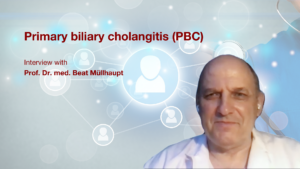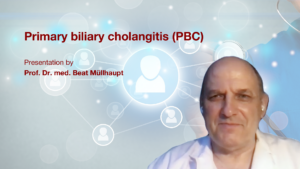Primary biliary cholangitis (PBC)
Primary biliary cholangitis (formerly primary biliary cirrhosis) one of the rarest autoimmune liver diseases. This rare liver disase affects more women than men. With targeted treatments, up to two-thirds of those affected today do not go on to develop cirrhosis.
In lab results, there is predominantly an increase in alkaline phosphatase and, in the advanced stage, also in bilirubin, which can be seen in yellow discolouration of the skin (jaundice) and the whites of the eyes. Antimitochondrial antibodies in the blood are also very typical for PBC.
Causes
PBC causes an inflammatory reaction in the liver. This leads to increasing destruction of the small bile ducts and can lead to progressive scarring of the liver (fibrosis) over decades. The cause of PBC has not yet been identified. It is believed that both genetic factors and environmental factors play a role.
Symptoms
Fatigue, itching and joint pain are the main symptoms. The symptoms, which vary in severity from person to person, can be countered with appropriate measures.
To make it easier to deal with fatigue, relaxation exercises, sporting activities and sleep hygiene can lead to an improvement in wellbeing. Optimising fluid balance and vitamin intake are also possibilities.
If the common symptom of itchiness occurs, medicines such as cholestyramine, rifampicin or the opioid antagonists naltrexone/nalmefene.
Osteoporosis, dry mucous membranes of the eyes, mouth and genitals, and restless legs when lying down (restless legs syndrome) are sometimes associated with PBC.
Diagnosis
If PBC is suspected, the patient’s liver values are checked using blood tests. If levels of alkaline phosphatase and / or gamma-GT are elevated, the diagnosis can be confirmed by the presence of anti-mitochondrial antibodies. An increased level of bilirubin usually indicates a more advanced stage of the disease.
A needle biopsy of the liver is not necessary for diagnosis. In atypical cases, tissue examination under the microscope can be useful. Biopsy reveals the typical PBC-related damage of the bile ducts.
Treatment
Ursodeoxycholic acid (UDCA) is used to treat PBC. Ursodeoxycholic acid is a bile acid that is practically identical to the body's own bile acid and therefore hardly causes any side effects. PBC cannot be cured and so the tablets are recommended for life. In the early stage, in particular, medicines are particularly effective and slow down the course of the illness, and in some cases even stop it. When used in the later phase of the illness, the medicines are not as effective.
Obeticholic acid has also been approved for the treatment of PBC since 2018. However, this tends to be only for patients who do not respond adequately to UDCA or who cannot tolerate UDCA. It can be combined with ursodeoxycholic acid or used alone. The costs of this treatment are not automatically covered so a cost credit application must be submitted to the health insurance company before treatment begins.
Unpleasant side effects include itching and raised cholesterol. If advanced liver cirrhosis is already present, OCA must be urgently given at a low dose, because metabolism is already limited in this case and so the drug can quickly lead to overdose and complications such as liver failure.
Fibrates, drugs that have long been approved for the treatment of increased blood lipids in Switzerland, can lead to an improvement in symptoms (especially itching) and liver values in patients who do not respond adequately to UDCA or who cannot tolerate UDCA. When used to treat PBC, the treatment is outside of the official drug approval (off-label use). Possible side effects of fibrates include increased liver values or impaired kidney function.
Studies are currently being carried out to investigate other substances to treat PBC, which could be considered as a supplement or substitute for ursodeoxycholic acid in the future.
Whether additional immunosuppressive drugs are useful in the case of PBC alone is now in doubt. In the event of overlap syndrome, namely PBC with autoimmune hepatitis, immune-suppressing therapy has been shown to have a supportive effect.
As with every chronic liver disease, a diagnosis of PBC means avoiding alcohol and nicotine is recommended.
If a liver transplant is necessary, AMA antibodies remain in the blood. However, in three-quarters of cases the liver disease settles down. In about a quarter to a third of patients, damage typical of PBC occurs again in the new organ, but usually remains mild.
Primary biliary cholangitis (PBC): Interview with Prof. Dr. med. Beat Müllhaupt
“What is primary biliary cholangitis (PBC)?” For those affected and interested patients, these and other significant questions will be expertly answered by Prof. Müllhaupt. In a first insight, you will get a comprehensive overview of this rare chronic liver disease. This important source of information can help you to better discuss your specific questions with…
Primary biliary cholangitis (PBC): Presentation by Prof. Dr. med. Beat Müllhaupt
“How can the clinical picture of primary biliary cholangitis (PBC) be brought closer to those affected and their relatives?” Prof. Müllhaupt presents the following related topics: Definition, bile duct system, frequency, cause, diagnosis, therapy options, pregnancy, transplantation, the different stages that a patient with PBC can go through and how the clinical picture shows itself.…
Primary biliary cholangitis (PBC): Interview with Patient Fabienne
“Can you explain to me what primary biliary cholangitis (PBC) is?” I ask patient Fabienne these and other very personal questions in this exciting interview. She describes her experience of being diagnosed with PBC at such a young age and living with it courageously. Wishes, fulfilment and happiness with big decisions are not neglected either.…



